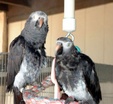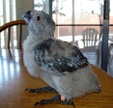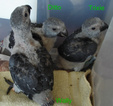
1
Scooter-Pie (right) and Sammy (left), are the proud parents of the babies featured in this slide show. The two have just taken a misting bath and are drying out in their outdoor play area which is completely enclosed to protect them from predators.
| 
2
African Grey parrots are native to the Ivory Coast, Ghana, Togo, Dahomey, Nigeria,Cameroon, Central African Republic, Zaire, Uganda, western Kenya, the Congo Republic, Equatorial Guinea, the islands of Principe and Fernando Po.
| 
3
They inhabit the densest jungle on the African continent.
|

4
Equatorial birds, African Greys are used to a warm climate and abundant forests.
| 
5
Greys are believed to nest and produce eggs during rainy seasons. Eggs go through an incubation period of 28 to 30 days. The chicks in this picture are between 9 and 4 days.
| 
6
Nests are found in deep holes in tree trunks that are deep and hidden far from human dwellings. Parents use their beaks to enlarge existing, natural holes, and gnaw away at the wood until a comfortable sized nest is carved out. Only one pair will nest in any tree, and there they will lay three or maybe four eggs.
|

7
February 19
In the wild these babies would be in almost complete darkness snuggled deep in the hollow carved out their parents
| 
8
February 23, 2006
Timnehs are similar in looks to the larger red-tailed, or Congo greys, but with some marked differences. Timnehs are much smaller, weighing in at 250-325 grams. Their basic build is usually more slender. The upper beak is bone-colored instead of black, and their feathering is much darker than a Congo's. Tail feathers are a deep lustrous maroon.
(Wally on left, Trixie in middle, Ditto on right.)
| 
9
February 23, 2006
This clutch of 3 in the album belong to Scooter-Pie and Sammy tame Timneh Gray Parrots.
(Wally in the middle.)
|

10
February 26, 2006
Parrot parents work as a team in raising their young. The mother (hen) stays in the nest with the babies while the father forages for food to bring back to mommy.
(Wally)
| 
11
February 26, 2006.
When the father finds food, he eats it and then flys back to the nest and feeds the mother.
This is the oldest, Ditto. The babies are able to hold their heads up for longer periods now.
| 
12
February 28, 2006
The mother eats what daddy has given her and in turn feeds it to the babies.
The babies at this age try to find the warmest place. They pile on top of and under each other for warmth.
|

13
February 28, 2006
Pictured at 16 days old these babies would be fed by their parents at least every 2 hours during daylight hours. According to the. Lexicon of Parrots these babies' diet would consist of seeds, nuts, fruits, berries, nectar and occasionally millet when daddy forages in millet fields. African Greys prefer fruit of oil palm (Elaeis guinensis).
| 
14
March 6, 2006
DNA sexed, the babies have been renamed.
This is Wally, DNA'd female (now known named Molly) the second to hatch.
The first to hatch is Ditto, DNA'd male.(renamed Rocket, now Pecos)
The third to hatch is Trixie, DNA'd female. She's still named Trixie.
| 
15
March 7, 2006
Left to right, is the youngest, Trixie, Ditto (now, named Pecos) the oldest and Wally the middle "Fid" (now, named Molly) on the right.
|

16
4 to 5 weeks old now. Their personalities are really starting to show.
Feeding time is really getting fun. Each one has their own unique begging technique.
| 
17
4 and 5 weeks
Give me food!
Wally (now Molly) was recently banded with a temporary band.
Just to avoid confusion later on.
She's on the right with the pink band on her left ankle.
| 
18
4 and 5 weeks
Here you see Sammy (on right) and Scooter-Pie feeding their babies. What is unusual about this pair, is that they interacted with their humans and all, parrots and humans, shared in the care and feeding of these babies.
|

19
March 11, 2006. (babies are about 5 weeks old here)
Family bonding time.
As the babies grew Sammy changed his role. He went from helping with the feedings to protecting and patrolling the area where they were.
| 
20
More Family activity, babies are about 5 weeks old. Mama Scooter-Pie is on the left.
| 
21
March 15, 2006, 6 weeks old.
Ain't I cute?
I think I ate to much.
(Trixie on the right, Wally left.)
|

22
March 17, 2006
I'm bigger an' older so I'm da boss aroun' here.
So, are you hungry?
Molly is in the middle, Trixie is waiting for Molly to feed her. This happened alot between them.
| 
23
Pictured at 6 weeks, these babies are being weaned by their human parents. Cheerios seems to have made it on the yummy food list.
| 
24
Here the babies are trying out some pellets. In the wild, TAGS (timneh african greys) of course would not be eating cheerios or pellets since they do not grow on trees and are not found on the ground in their natural habitat.
Notice how much darker Ditto's face is? He turned out to be the only male.
|

25
Wally, now named Molly posing for her portrait.
| 
26
March 15, 2006.
Trixie (right) trying to get her sister to wake up.
The babies get very sleepy after the morning weigh-ins and feedings.
| 
27
March 15, 2006.
Trixie is quite vocal now. She loves to play with her voice.
|

28
March 19, 2006 (about 6 weeks old)
Trixie is learning to control her head feather reactions. She is often seen with them sticking straight up. So cute!
Ditto has his under control already.
We noticed if they are curious, frightened or excited the head feathers will rise.
| 
29
March 19, Wally and Gavin.
Wally loves to snuggle.
| 
30
March 22, 2006
One month and 20 days old, these rascals are feathering up quickly! This is a very painful stage for young parrots, as lots of pin feathers emerge through their skin.
When sleepy they all snuggle into a corner. Sometime it is hard to tell where one ends and the other one starts.
|